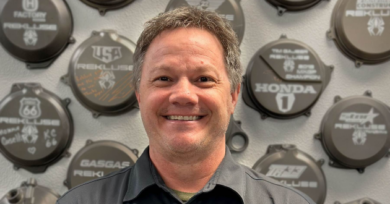May 3, 2010: Satisfying the female rider
By Karin Gelschus
Associate Editor
It’s no secret women tend to be pickier than men, for the most part, when it comes to clothing. That doesn’t mean, however, dealers need to carry half a dozen different lines in eight
different colors.
Female riders can be satisfied with just a couple clothing lines as long as they have full size ranges and the different colors are displayed.
Along with detailing sizing and color schemes, retail merchandising experts lay out the basic essentials dealers need to please a female rider in the dealership as well as address common misconceptions and mistakes dealers make in ordering women’s apparel.
An important thing to remember is that “it’s a self-fulfilling prophecy,” said Claire Maguire, national brand manager of powersports clothing company Fieldsheer.
Often times, industry associates think women riders consist of only new bike buyers, which is about 12 percent of all new bike buyers, according to the 2009 J.D. Power and Associates Motorcycle Competitive Information Study.
Of the total male new bike buyers, Jennifer Robison, national retail specialist for Tucker Rocky, says 62 percent of them are married.
“You can pretty much guarantee the wife is going to go at least once,” she said. “You have to count all of them.”
Sizing
One of the most potential confusing aspects of women’s clothing is the sizing. However, it doesn’t have to be complicated. The biggest mistake dealers make is not having large enough sizes, says Maguire.
“As far as the selection, the most important thing is to have a full size run of something,” she said. “A lot of brands now carry plus sizes, especially in the women’s cruising and touring segment. It’s embarrassing not to have a size big enough. Make sure you have all the sizes up to plus sizes, not just the sizes for petite girls. If you don’t have big enough sizes, you end up putting them in a men’s jacket, and it doesn’t fit at all. The back pad is too big, the shoulders are in the wrong place.”
A key thing to remember is the average U.S. woman wears a size 14, which in general, equates to an XL. That’s where the size plus-sized clothing begins. In addition, one-third of all American women wear a size 16 or larger, which is equal to XXL.
“It’s really important to understand what common sizing is,” Robison noted.
At motorcycle shows, Maguire says the bigger sizes are always the biggest sellers.
“When we had retail shows, we sold plus sizes to the women because they could never find them anywhere else,” Maguire said. “Dealers are missing the boat by not catering to that customer base. Be aware that there are brands that make plus sizes and tall sizes.”
It’s crucial to have full size runs, especially for the women who don’t ride often, says Robison.
“If a woman is an occasional buyer, you have one shot at her,” she said. “If you’re going to stock them, you better do full size runs. A woman who is larger is going to be embarrassed to order a size 16 or a size 18. That would be the biggest insult you could make.”
To help ease size issues, Maguire suggests having sizing charts in the apparel section.
“With the sizing charts, it shows there is a wide range of sizes available, so they’re more comfortable in looking for something rather than just settling,” she said. “Take whatever brand you’re stocking, make a copy of their sizing chart, laminate it and put it in the clothing section. At least then women can look and get an idea of what size they need, especially if they have to order a size.”
If the fit of the jacket is good, women are willing to pay extra, says Robison.
“Women will pay for it if they feel it flatters them and it fits good. You can close that deal easily,” she said, and added to keep in mind that women like options. “If you make her look good, she’ll spend more money on a coat if she really likes it. Besides a small percent, women are going to buy more than one jacket.”
Bare minimum inventory
At the absolute minimum, Maguire says dealerships should have a least one sport-style jacket and one line of a cruiser style.
“Sizing is very important to women, and it varies widely between brands,” she said. “Two different brands would be good because then you offer a wider range of sizing and cut.
“Cruisers tend to like a three-quarter jacket because of the way they’re styled and fitted. They’re more flattering. It’s also more comfortable when you’re sitting in a riding position.”
For the bare essentials, Robison says most of a dealer’s jackets need to be three-quarter length, not waist length.
“It’s really important to look at the construction of the jacket, that it has the ability to adjust for the fit,” she said. “Make 20 percent of your jackets women’s; that could be six jackets. I’d pick 2-3, three-quarter length jackets, one of those should be pink, not all of them should be black. You need to look at some half-length jackets too.”
As for colors, have a full black line with a couple other colors.
“If you’re doing a size run, and they come in pink and blue, alternate, so have a small blue, medium pink, large black,” said Maguire. “That way they can see the colors available, but if that color isn’t in their size, they can order it, but they know it fits and it’s the color they want.”
Currently, women are leaning toward accent colors, says Kathy Whalen, manager, Harley-Davidson’s MotorClothes , Women’s Division.
“For H-D MotorClothes riding gear, women tend to prefer an accent of color rather than all black,” she said. “Currently the customer favorites for color in women’s gear are pink, purple and/or blue.”
Other popular clothing among women is apparel that supports charitable causes.
“Women want to support each other,” Whalen said. “Our recently introduced Pink Label line of MotorClothes has proven very popular because the styles are a fresh take on favorite silhouettes, and also because a portion of the sales go to support a great charity, the Breast Cancer Network of Strength.”
Placement in store
The women’s and kids clothing should be toward the front of the store, says Robison.
“The women’s stuff should always be up front. If they come in as a couple, he’s going to go to the salesman, parts counter or service, and she would be bored to death with those conversations, so she’s going to peel off and look at the retail,” she said. “Women and kids up front. It doesn’t necessarily have to be a women’s department.”
While it doesn’t have to be a separate department, Maguire says it’s important to break it out from the men’s apparel.
“Have pictures and posters of women or a lady mannikin,” she said. “When they come into a store, they’ll automatically gravitate toward the section.”
Also essential to a women’s section is a full-length mirror. “Women want to see what they look like,” Maguire said. “Mirror is a key essential. And have a chair, something that’s comfortable, so they can sit and try on the pants or boots.”




